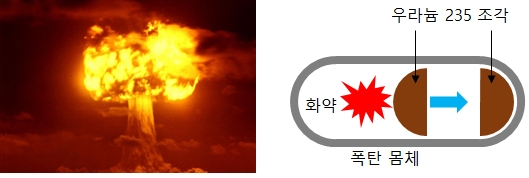Caution
- This simulation is intended to understand the principle of fission, and the proportions of the model presented may not match the reality.
- The nucleus was exaggerated and drawed large.
- The electrons around the nucleus were not shown.
The principle of exponential explosion
When neutrons split a uranium nucleus, it gives off 2×108eV of energy. Compared to one TNT molecule producing 30 eV of energy, it is a huge amount (about 6.66 million times difference).
After fission, the mass of the fission byproduct plus the neutron's mass is less than the original mass of uranium.
The mass decreases slightly but produces a lot of energy by Einstein's famous formula E=mc2. The energy from nuclear fission comes as the kinetic energy of the fission byproduct. And part of it is used to generate neutrons, and the remaining part comes out as gamma rays (r -ray).

Scientists were shocked by this fission. This is because nuclear fission not only produces tremendous energy but also generates neutrons. Usually, when one neutron causes nuclear fission, there are about two to three neutrons emitted. If a newly released neutron causes fission in another nucleus, it can produce 8 to 27 neutrons again, causing a nuclear chain reaction.
Does nuclear fission often occur in nature?
Nuclear fission does not occur in nature. In fact, the chain reaction is only possible with the rare isotope of uranium, 235U, because only 0.7% of the uranium metal is present. 238U, which makes up most uranium metal, absorbs neutrons. Therefore, the chain reaction becomes impossible.
Critical mass
If the fission reaction occurs in a small mass, the chain reaction cannot continue because many neutrons escape through the surface. This is because small objects have a large surface area compared to their volume.
There is a minimum size of a substance that can cause a chain reaction, which is called the 'critical size,' and the mass is called the 'critical mass.'

Atomic bombs were created using rapid fission. Masses smaller than the critical mass do not explode. Multiple chunks of 235U are suddenly merged to detonate a bomb. Then, the total mass becomes more than the critical mass, so it explodes rapidly.
(Chemistry-The Central Science)

Nuclear power plants are places that allow nuclear fission to occur slowly.